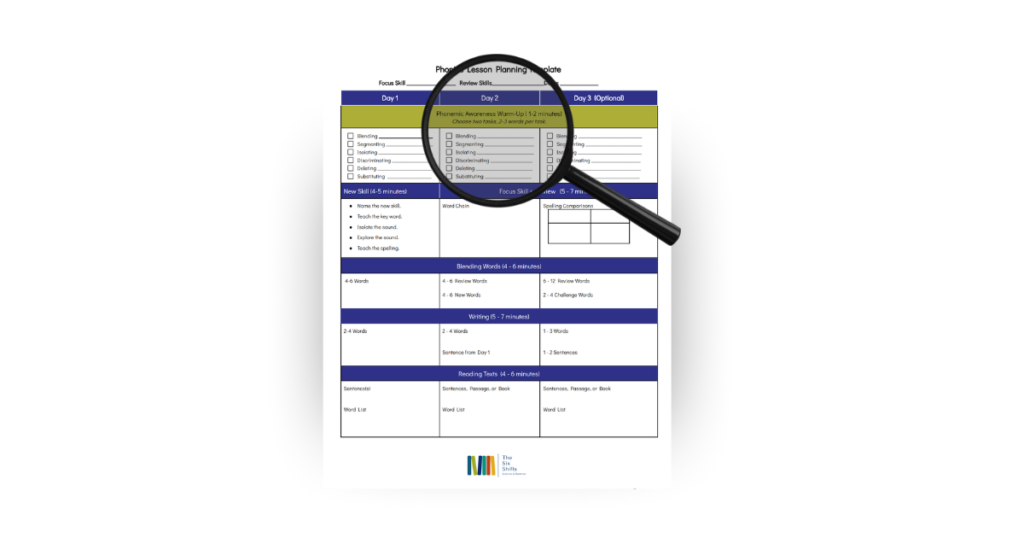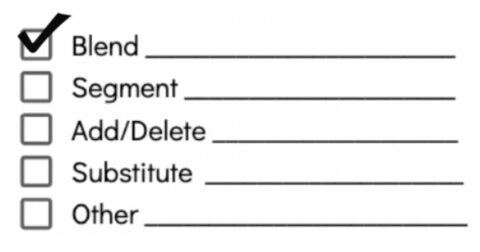Let’s get reeeeaaadyy for a warm-up!
No, not that kind of warm-up! The phonemic awareness warm-up portion of the Explicit Phonics Lesson Template won’t have you breaking a sweat, but it WILL support your students while they exercise their phonological processors!
Last week, we shared our explicit Phonics Lesson Template that can be used with any phonics concept or sequence. It is designed to support both whole-group and small-group instruction.
When you print the template, you will notice it isn’t just one page. But there are actually additional pages of supportive guidance so you can hit the ground running with your students tomorrow!
Page 1 provides a general overview of the lesson structure.
Page 2 is the actual lesson template,
Page 3 – 10 provide more in-depth support and examples for each of the seven flexible lesson components.
Today, we want to take a step-by-step walkthrough of the first lesson component on the Template, the “Phonemic Awareness Warm Up,” Every phonics lesson in the flexible 2-5 day sequence begins with this important component.
Why begin with phonemic awareness? Well, shifting phonics instruction from a PRINT to SPEECH model to a SPEECH to PRINT approach means starting with spoken language!
So before we tune into letters, let’s tune into phonemes or the individual sounds within words. This phonological warmup will allow students to hear and manipulate target sounds within whole words before they are expected to read them in print or write them.
This warm-up is quick and explicit, and best of all it doesn’t require any “stuff” because it is all done verbally and auditorily.
2 Simple Steps to Plan in a Snap
1. Pick 1-2 PHONEMIC AWARENESS skills to practice each day during the warm-up. The type of warm-up depends on your students’ needs.
To build phonologic sensitivity in K-2, blending and segmenting are essential power skills. We suggest starting there!
2. Select words for the PA warm-up that contain examples of the target phonics skills you’ll focus on in the rest of the lesson.
For example, if the target PHONICS skill for this sequence is short A, as in cat, then you will want to select words that have short A sounds in them for the PHONEMIC AWARENESS practice, too.
In our example, we’ve included words with the short a sound that have 3 phonemes. Because this warm-up doesn’t include letters, we even included consonant digraphs. Remember, children aren’t SEEING these words and sounds – they are HEARING and SAYING them.
If you aren’t familiar with our phonemic awareness tools, there are a few that you might find helpful in planning for this step:
- The Phonemic Awareness Skills Development Tool is a ready-to-use resource that contains word lists and language prompts to make lesson planning for phonemic awareness instruction efficient and powerful. The lists are organized from less to more complex skills and word types.
- The Phonemic Awareness Progress Records download provides a few different tools to help you gather information about the skills of individual students so you can make an informed decision about where to go next. The tools can be used to capture data from either informal observation or more formal practice sessions. The download includes options for individual and group data collection.
With your phonics template in hand, and possibly our phonemic awareness tools to support you, you’re ready to go.
Just two decisions, really.
What phonemic awareness skill(s) do your students need to focus on next?
What words will you use to provide that practice?
Next week, we’ll meet you back here to walk through the second component of the lesson: “Explicit Skill Practice.”
Explore our 8-part blog series “Using our Flexible Phonics Lesson Template.”👇
Using Our Flexible Phonics Lesson Template (Part 1): An Introduction
Using Our Flexible Phonics Lesson Template (Part 2): The Phonemic Awareness Warm-up
Using Our Flexible Phonics Lesson Template (Part 3): Explicit Skills Practice
Using Our Flexible Phonics Lesson Template (Part 4): Blending Words
Using Our Flexible Phonics Lesson Template (Part 5): Writing
Using Our Flexible Phonics Lesson Template (Part 6): Reading Text
Using our Flexible Phonics Lesson Template (Part 7): Word Chains
Using our Flexible Phonics Lesson Template (Part 8): Spelling Comparisons
-
Jan Burkins and Kari Yates are authors, speakers, and consultants, who are dedicated to helping teachers around the world translate reading science into simple instructional moves that help teachers make learning to read easier for their students while still centering meaning-making, engagement, and joy.
Recent Posts








Recent Comments